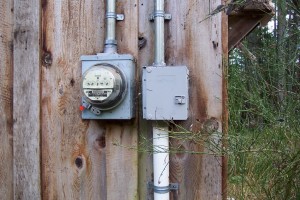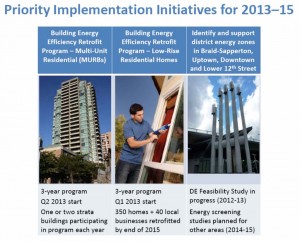As a student of science, I am familiar with the Observer Effect in physics. It says that one cannot measure a phenomenon without affecting it, since measurement alone relies on interacting with what you try to measure. In most physical process this is not really a very big problem, as the impact of interaction with the measured phenomenon is usually orders of magnitude smaller than the precision of the measuring tool. So the energy drawn from a swimming pool by the mercury thermometer used to measure it is not zero, but it is so small that it does not have a meaningful effect on the reading. However, at the nano-scale (or in the quantum realm), this can end up being very important: to measure the location of an electron, it must interact with a photon, an interaction that fundamentally changes the properties of the electron being measured.
Apparently, it is also important when it comes to measuring household energy use in BC. Not even the monumental Site C Dam project or the never-ending IPP/Run-of-the-River fiasco have caused as many headaches to BC Hydro as the Smart Meter Program. But what does it mean for New Westminster?
 |
A non-smart meter in the middle of the woods, a hassle to read that
I’m sure BC Hydro would rather avoid (Courtesy Lac Tigre Broom Farms) |
BC Hydro had to replace their old analogue mechanical meters, and so does New Westminster at some point in the next year or two. This all goes back (believe it or not) to changes at the federal government level. The electrical meter on the side of your house is a measuring instrument used for trade, and therefore is its subject to federal laws regarding their accuracy. Just like the tag at the gas pump that indicates the last time the pump was calibrated, the meter on your house must be demonstrably accurate.
Now, an electrical meter is a pretty high-precision instrument, and is generally operated by a government agency, so the standards for assuring accuracy are not quite as onerous as the gas pump at Ed’s Gas or the weight scale at Thrifty Foods. Instead of testing every single meter on every single house, the Federal Agency “Measurement Canada” has a randomized verification system. Every so often Measurement Canada requests that some number (around 2 dozen) of the New Westminster Electrical Utility’s meters be sent to Ottawa to assure they are accurate and precise. To assure the selection is random, the agency request specific meters from the long list of serial numbers that they have on file for New Westminster Electrical Utility. The Utility then goes to those houses or businesses, pulls the meter off the wall (replacing it with a spare), and ships it to Ottawa. If those all pass the precision tests, the City gets a pass. If one or more are outside of acceptable limits, then a larger cohort is sent to Ottawa to see if the issue is systematic or a one-off. In theory, if enough are off, the Feds will come and test all of the meters or force the Utility to replace them all.
The problem arising right now is that Measurement Canada will no longer be supporting the older mechanical meters. They are getting out of the business of testing old technology, and will only test the newer digital devices in the future. So if New Westminster still wants to sell electricity, they may be forced to update their meters.
 |
| A typical old-school New Westminster meter. |
Note –the old meters still work! Yes, some wear out, and some need occasional repair, but the current meters have a very long service life (being well-built mechanical devices dealing with very light loads), and it has been suggested that with regular maintenance they could easily service us for another 50 years. However, the federal regulations are changing, forcing the utility to replace them. So they are going to the junk pile, operational or not.
The City’s Electrical utility and City Council have stated several times that the much-maligned Corix-installed Wireless Smart Meter chosen by BC Hydro is only one of several options available to them. The new meter will no doubt be digital, but pretty much everything else about it is up in the air. Will it continue to be read by humans going door-to-door? Will it wirelessly transmit data via some sort of SCADA setup? Will it transmit data automatically over attached wires?
These will no doubt be part of a complicated cost/benefit discussion in the City, and it appears there is going to be a public component to this discussion. At a recent NWEP Energy Group meeting, some of these issues came up, and if that small group is any sign- this will be a spirited discussion. Here are some of the points from my viewpoint (and, I hasten to add, many of these opinions were not shared by some other NWEP members – some even hold almost-opposite opinions, which makes me think the larger public discussion with be a compelling one!)
• Wireless Smart Meters don’t cause cancer, lupus, chronic fatigue, scabies, Alzheimer ’s disease, ADHD, autism, or any of the other thousands of afflictions allegedly linked to them. Magda Havas is a terrible scientist, and should be held accountable for stoking irrational public fears. The non-effect of daily exposure to low levels of non-ionizing radiation is not controversial in science community, nor are the alleged links to a myriad of conditions novel or untested to science. There is a significant body of science going back more than 100 years assessing the impacts of human exposure to non-ionizing radiation, including ubiquitous man-made radio waves, and even more ubiquitous solar radiation in the same frequency bands.
• There are significant advantages to developing a “smarter grid” for electrical distribution. Leakages from the system and electricity theft become much easier to detect and eliminate, disaster response and emergency planning are improved. Whether these advantages rely on real-time monitoring through wired or wireless systems should be a determinant if we adopt those technologies;
• The ability to track electricity use in real time provides the ability for people to be more conservative with electricity use in their everyday life. Arming consumers with more information about their purchases should be a good thing! Consumers generally do not want to waste their money, and when given the tools to easily make changes to save electricity, they will usually adopt them. So let’s give them the tools.I would love a meter smart enough that I can collect analytic info off of it to tell me how I use my power. This should be an option available to users, as it will incentivize conservation;
• Any new meter system should accommodate homeowner co-generation. We have a City full of south-facing roofs that may someday include photovoltaic systems, we may have district energy systems or backyard turbine systems. In the next generation, we may find some of our businesses (especially in light industrial areas) may be producing surplus energy they would like to sell back to the grid. If time-of-day pricing is adopted by BC Hydro, then there will be a market for decentralized energy storage and re-distribution. We need to start preparing for this future now.
It has been noted that New Westminster is lucky. In having our own utility, we have the ability to make our own decisions about this, and it seems the Utility and Council are happy to include the public in that discussion. We don’t have to deal with Darth Coleman, and his seemingly random and disjointed decision making about a project that is being administered by a Crown Corporation that is (in theory) supposed to be operated at arms-length from Government.
It is no-where as much as the Smart Meter program where Darth Coleman’s ability to muck about in things that would just be better if he stayed out of the story. At one point not three days ago, he was insisting that BC Hydro will force everyone to install a Smart Meter once their re-education is complete. As of yesterday, Darth seems to have changed his stance, saying that they will not force Smart Meters on those customers that hold out, or they will wait until after the election, or something- it is pretty unclear right now. At least this is a place where the BC NDP have been clear: they will turn the mess over to the BC Utilities Commission, who is should be in a better position to make a decision for the long term good of the Utility than a soon-to-be-in-opposition bully from Langley.
As it stands, we can throw the final implementation of the Smart Grid across BC onto the growing pile of landmines that the current government has laid in the path of the poor bastards who win the May Election, along with BC Hydro deferred debt, unsustainable BC Hydro Rates, the Falcon Gate fiasco, unrealistic traffic projections for Port Mann tolls, the ongoing TransLink budget crisis, the potential shuttering of AirCare, ongoing structural deficits, the long-delayed update of the Water Act, the collapse of the BC timber supply, etc., etc.
If there is a single piece of evidence that even the BC Liberals know they are headed for the political wilderness, it is the path they are laying for the province in the year to come. They would be crazy to want to win the election…
We also have to remember that we in New Westminster are not immune to the effects of BC Hydro mis-overlording. We buy all of our electricity from BC Hydro, so just as Hydro rates are sure to skyrocket over the next 5 years when the offset debt, smart meter bills, Ministerial interference in the Utility Commission’s work, IPP contracts, and Site C shit all hit their collective fans, New Westminster rates will surely follow. I hope I have a meter smart enough to help me find the savings in my household electricity bill by then.





